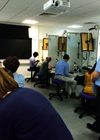Unfortunately, I had the pleasure of getting to know this exam intimately. With adequate preparation this does not have to be the case for most people.
The exam has recently changed to consist of 10 OSCE style stations (previously 12). Six of these are retinoscopies. The other four are sphere refinement, binocular balance, cyl refinement and focimetry.
Firstly, have a look at where and when would be most convenient for you to sit the exam, London, Glasgow or Birmingham, and book your study leave. Ideally have a week of study leave before the exam and over the three-day period of the exam itself.
To get your head around the exam, familiarise yourself with the ‘Further information’ section on the Refraction Certificate page of the RCOphth website, which includes useful pearls on how to refract, how the exam runs on the day, how marks are allocated and sample marksheets for each station.
Next, ask someone who has sat the exam for their marked results sheet to see where marks are awarded for technique. Next, assimilate your equipment for the exam – this should include a retinoscope – for retting, 0.25, 0.50, 1.00 Jackson Cross Cylinders – for cyl refinement, a small microfibre cloth (for wiping grotty lenses), a pencil and eraser. Put all of these in a clear ziplocked bag. With the new exam format this is all you need on the day of the exam (all of these items are provided during the exam anyway, but it is comforting to have your own).

Exam kit.

Model eye for retinoscopy.
Find a model eye to practise on. These are excellent to see what the reflexes look like and realising when you are close to neutralisation.
Now, find your friendly hospital optometrist and ask to sit in with them to go through the basics. This is crucial to work on your retinoscopy / cyl-sphere refinement technique, figuring out your working distance, and familiarising yourself with the vision test charts as these are usually the same ones used for the exam. Also ask them to confirm your rets when you practise. Practising with a fellow exam taker is also a useful way to verify your measurements.
Use the bulk of your revision time focusing on retinoscopies, as these count for 60% of the exam. The patients for the exam are usually young optometry students with either a medium sphere and cyl, so choose who you practise your rets on carefully, to mimic exam conditions. Spending 30 minutes fighting an aphakic baby to get that perfect +20D reflex is interesting, but not useful for the exam! Young patients in eye casualty, relatives and friendly colleagues work best.
It is very variable how many people you have to ret to be exam ready. Once you’re getting consecutive rets very close to the optometrist’s measurements, you are ready! It is a common misconception that you get marked on technique for the retinoscopy stations. The marks boil down to how close you are to the actual prescription.
Aim to score highly on the sphere and cyl refinement and focimetry stations, these can help carry your overall score if you encounter some ‘dodgy’ rets on exam day. Write down your approach to all four of these stations and practise this routine over and over. Mount a trial frame with spheres and a cylinder and go through the routine of sphere and cyl refinement a few times. Learn the +1 blur back, duochrome and Modified Humphriss binocular balance tests and use two of them. If you have time, use all three. Appearing confident and practised during the exam will get you full marks for technique.
Borrow a focimeter for your clinics and use it for patients who come in with a known prescription. Try a couple of different models and get a feel for them, as models may vary during the exam. Usually the prescription for the exam is a bifocal pair, with a prism in one lens. Ask your friendly orthoptist to hang on to any old spectacles with prisms fitted in them. Alternatively, load a prism into the trial frame and see how it behaves under the focimeter. This station can be time pressured so get lots of practice. Usually a full day at your dispensing optician’s should be more than enough. Learn the basics of hand neutralisation of lenses but pray that it doesn’t come up!
The exam runs for about an hour and a half and feels fast paced. If a station doesn’t go well you must rapidly pick up your shattered confidence and move on, as you can’t afford to score low on more than a couple of stations. If you have time at the end of a station, double and triple check that your reflex is near neutralisation and that you have written down your findings appropriately. If you’re struggling with a reflex, ‘bracket’ as much as you can, and write down your best guess. Don’t chase 0.25 of a dioptre at the expense of running out of time! Write down your working distance and dioptric power in advance on the ret stations and write your answers clearly. Complete one eye at a time. With the sphere and cyl stations, be bold with your initial lens choices to avoid many small incremental changes and save time. If you’re up to 6/5 vision you should be very close to the end point.
Overall, prepare well so that you’re on autopilot on the day, keep your wits about you if there are any wobbles and you should be OK!
COMMENTS ARE WELCOME









